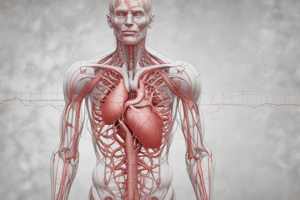Podcast
Questions and Answers
Total body water is either: Intracellular fluid (ICF): inside the cell & represent 2/3 of total body water or 40% of total body weight or
Total body water is either: Intracellular fluid (ICF): inside the cell & represent 2/3 of total body water or 40% of total body weight or
28 Liters
Extracellular fluid (ECF): outside the cell & represent 1/3 of total body water or 20 % of total body weight or
Extracellular fluid (ECF): outside the cell & represent 1/3 of total body water or 20 % of total body weight or
14 Liters
Interstitial: bathing the body cells and called internal environment (3/4 of ECF or 15% of total body weight or
Interstitial: bathing the body cells and called internal environment (3/4 of ECF or 15% of total body weight or
10.5 L
Intravascular: inside blood vessels (plasma) (1/4 of ECF or 5% of total body weight or
Intravascular: inside blood vessels (plasma) (1/4 of ECF or 5% of total body weight or
Transcellular fluid: small compartment (about ______). It includes fluid in the synovial, peritoneal, pericardial, and intraocular spaces, as well as the cerebrospinal fluid; it is usually considered to be a specialized type of ECF, although in some cases its composition may differ markedly from ECF. ICF & ECF are separated by the cell membranes which keeps the composition of the 2 fluids different.
Transcellular fluid: small compartment (about ______). It includes fluid in the synovial, peritoneal, pericardial, and intraocular spaces, as well as the cerebrospinal fluid; it is usually considered to be a specialized type of ECF, although in some cases its composition may differ markedly from ECF. ICF & ECF are separated by the cell membranes which keeps the composition of the 2 fluids different.
Age: Water in newly born infants represent ______ of total body weight but in old age, water represents only about 45%.
Age: Water in newly born infants represent ______ of total body weight but in old age, water represents only about 45%.
Fat content or the Body mass index (BMI): in obese persons water represent ______ only of total body weight.
Fat content or the Body mass index (BMI): in obese persons water represent ______ only of total body weight.
Sex: In females water represent ______ only of total body weight due to high fat content.
Sex: In females water represent ______ only of total body weight due to high fat content.
Intravascular: inside blood vessels (plasma) (1/4 of ECF or 5% of total body weight or ______.
Intravascular: inside blood vessels (plasma) (1/4 of ECF or 5% of total body weight or ______.
Extracellular fluid (ECF): outside the cell & represent 1/3 of total body water or ______ of total body weight or 14 Liters).
Extracellular fluid (ECF): outside the cell & represent 1/3 of total body water or ______ of total body weight or 14 Liters).
What are the two types of nitrogen-containing heterocyclic aromatic compounds?
What are the two types of nitrogen-containing heterocyclic aromatic compounds?
Name the pyrimidines that occur in DNA.
Name the pyrimidines that occur in DNA.
What are the principal purines of both DNA and RNA?
What are the principal purines of both DNA and RNA?
What is the end product of purine metabolism?
What is the end product of purine metabolism?
Name one disorder associated with purine metabolism.
Name one disorder associated with purine metabolism.
What are the common causes of primary metabolic gout?
What are the common causes of primary metabolic gout?
What is the prevalence of gout and which gender does it mostly affect?
What is the prevalence of gout and which gender does it mostly affect?
What is the most common complication of gout and how does it occur?
What is the most common complication of gout and how does it occur?
What is the treatment for gout involving the removal of urates from the joint and from the body?
What is the treatment for gout involving the removal of urates from the joint and from the body?
What is Lesch-Nyhan syndrome and who does it affect?
What is Lesch-Nyhan syndrome and who does it affect?
What are the important pyrimidines that occur in DNA?
What are the important pyrimidines that occur in DNA?
What are the principal purines of both DNA and RNA?
What are the principal purines of both DNA and RNA?
What are the end products of purine metabolism?
What are the end products of purine metabolism?
Name one disorder associated with purine metabolism.
Name one disorder associated with purine metabolism.
What are the names of the parent compounds of the two types of nitrogen-containing heterocyclic aromatic compounds?
What are the names of the parent compounds of the two types of nitrogen-containing heterocyclic aromatic compounds?
What is the prevalence of gout and which gender does it mostly affect?
What is the prevalence of gout and which gender does it mostly affect?
What are the common causes of primary metabolic gout?
What are the common causes of primary metabolic gout?
What is the most common complication of gout and how does it occur?
What is the most common complication of gout and how does it occur?
What is the treatment for gout involving the removal of urates from the joint and from the body?
What is the treatment for gout involving the removal of urates from the joint and from the body?
What is Lesch-Nyhan syndrome and who does it affect?
What is Lesch-Nyhan syndrome and who does it affect?




